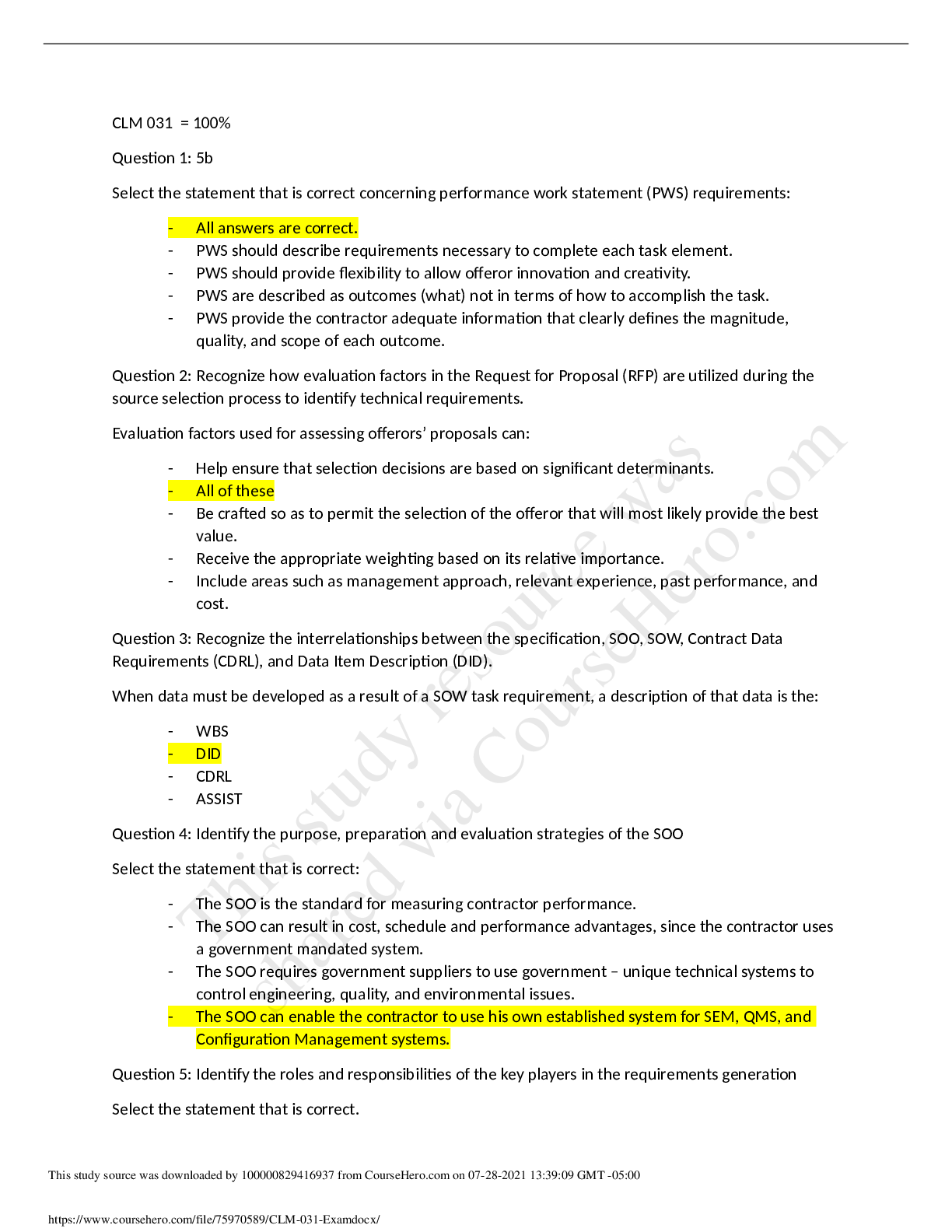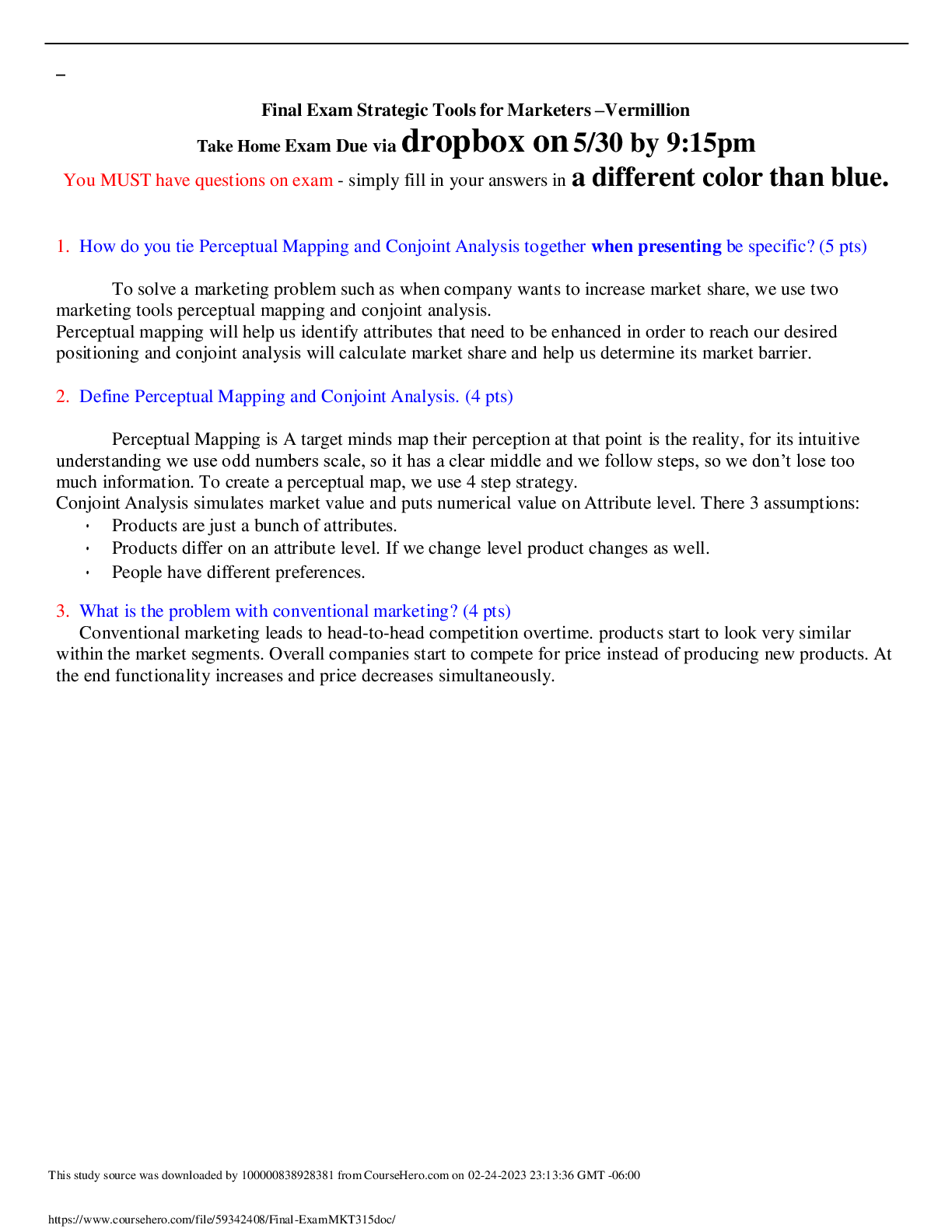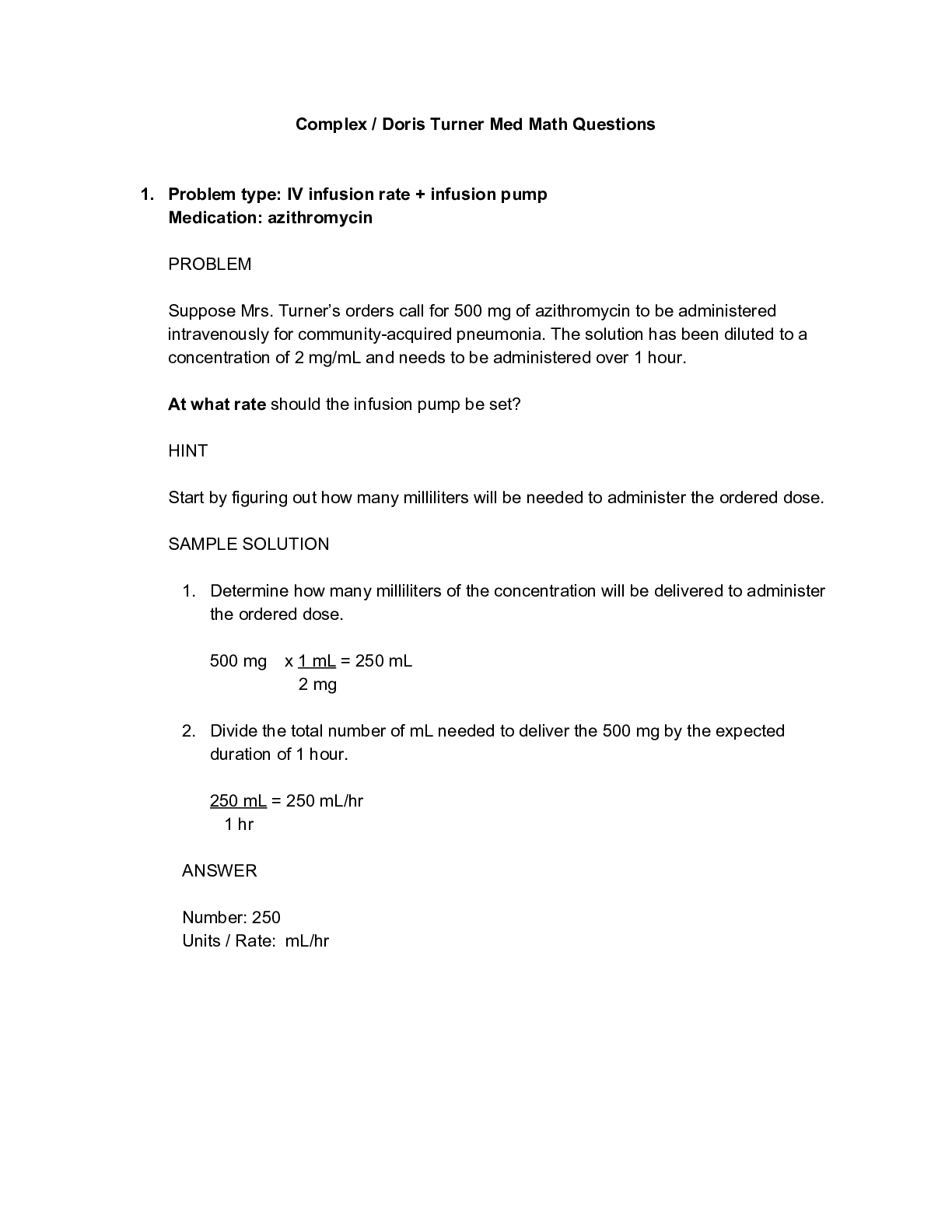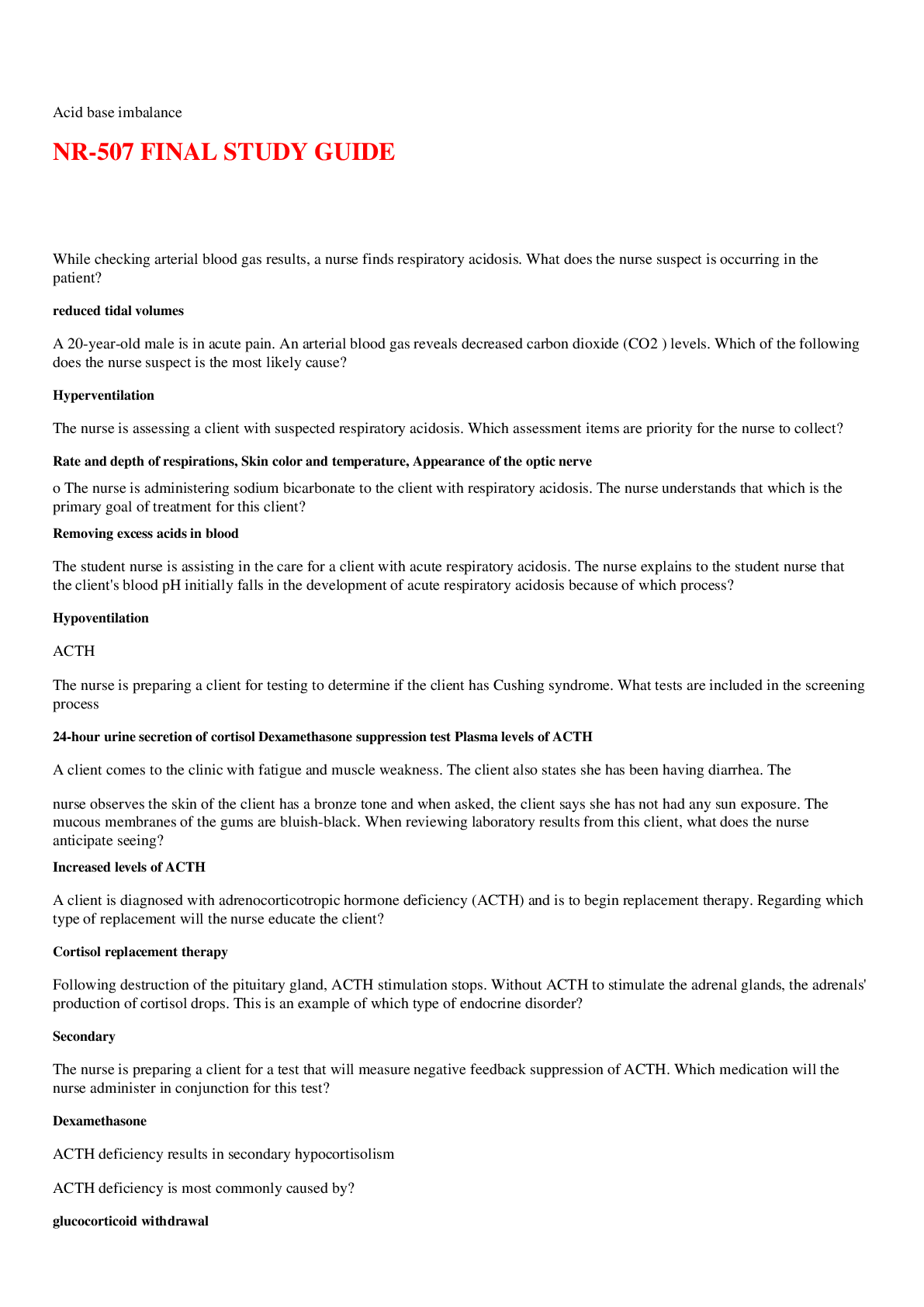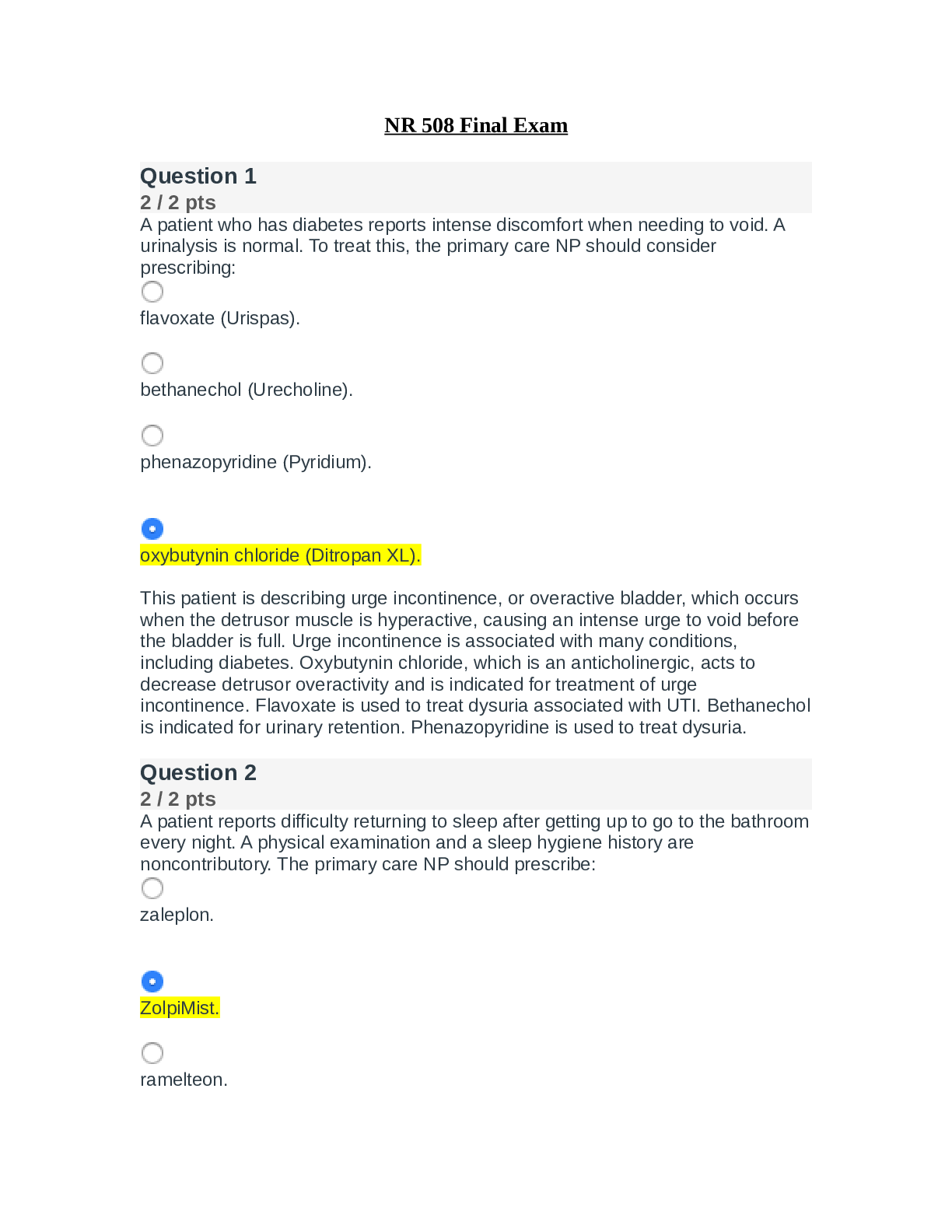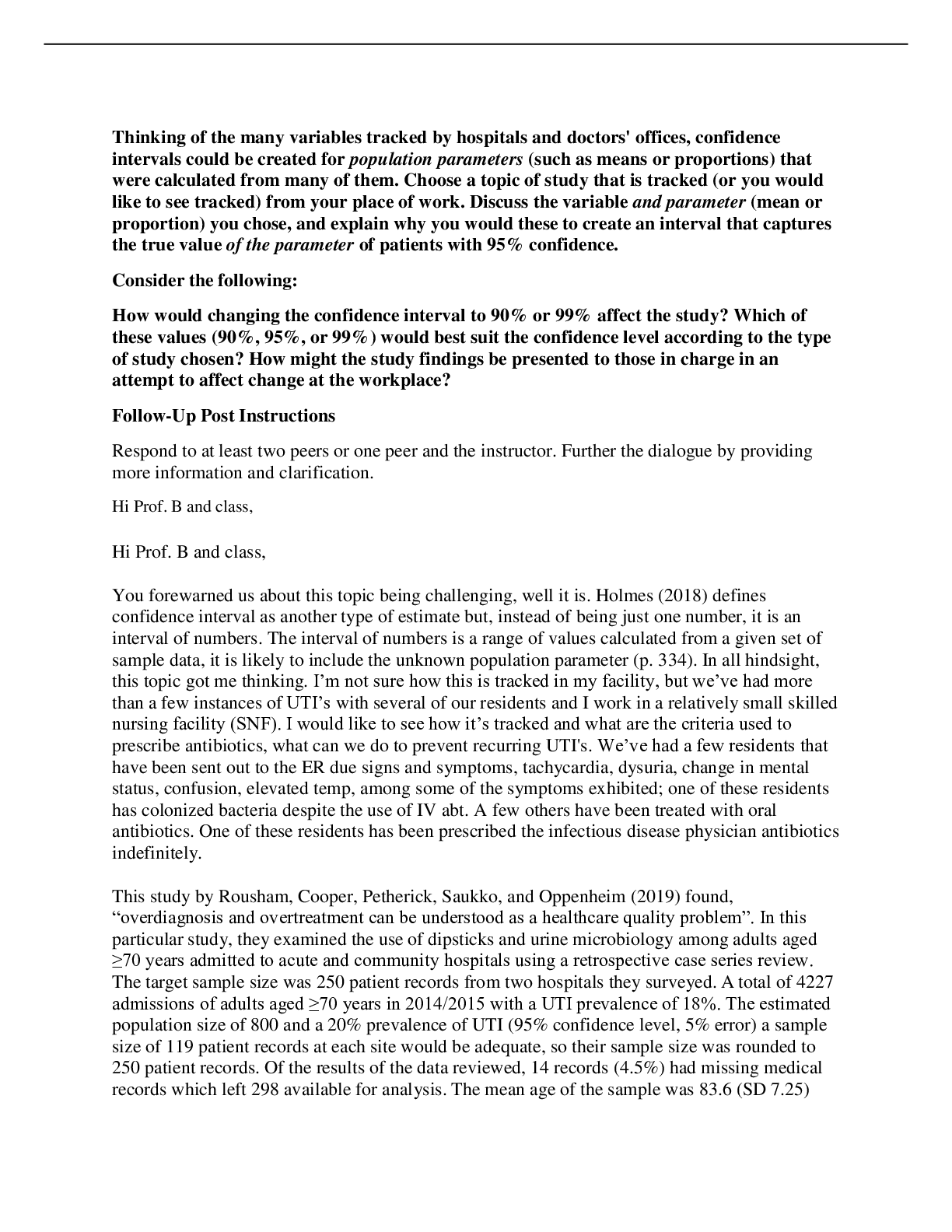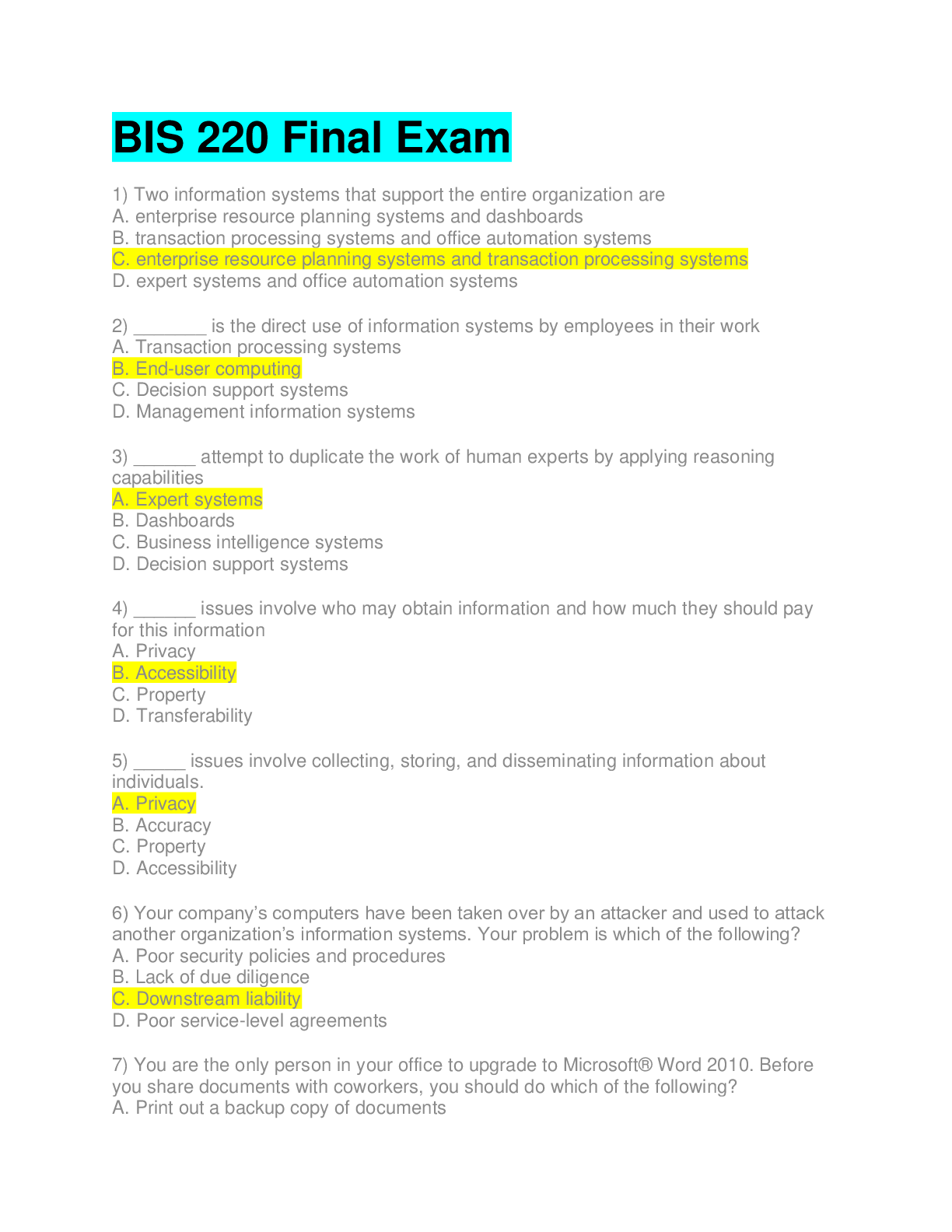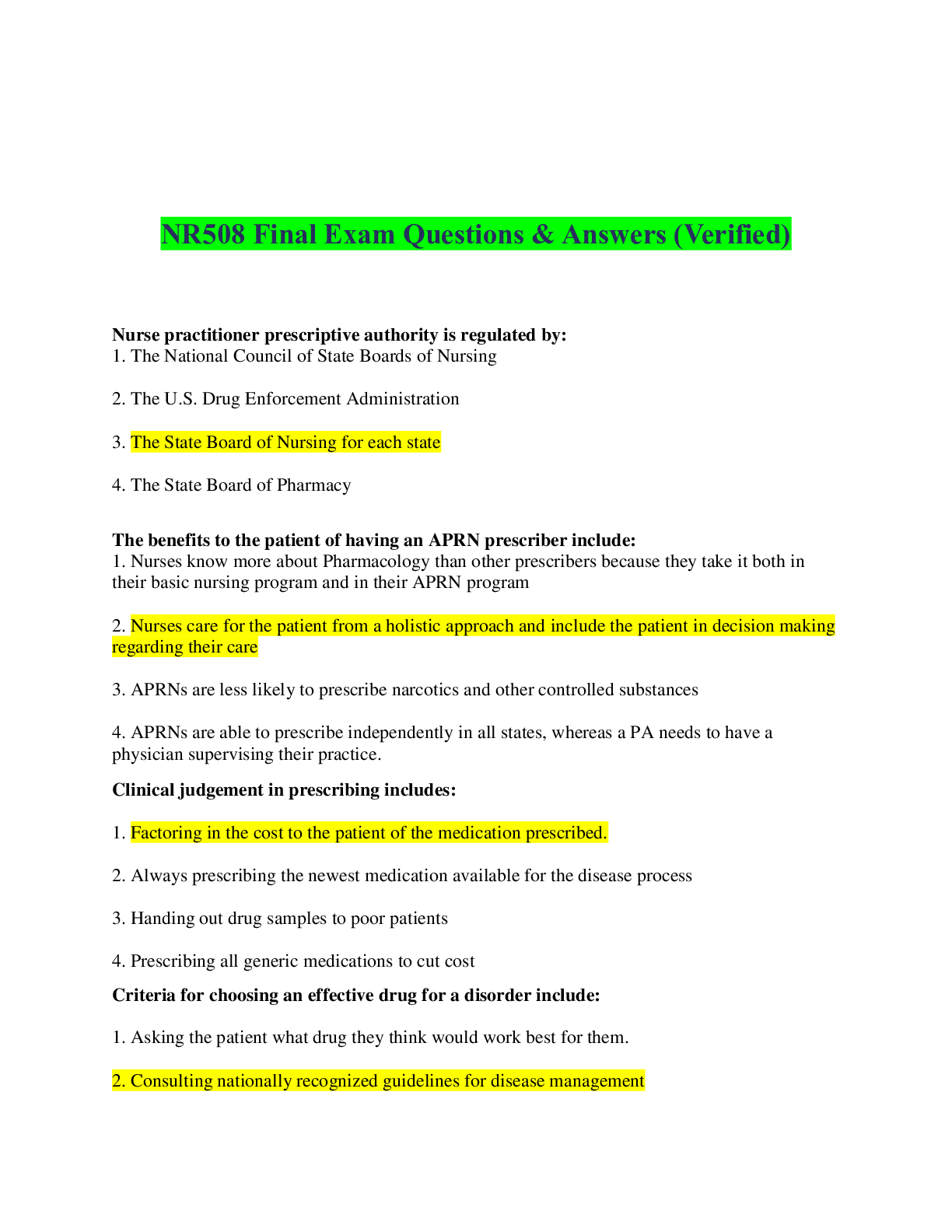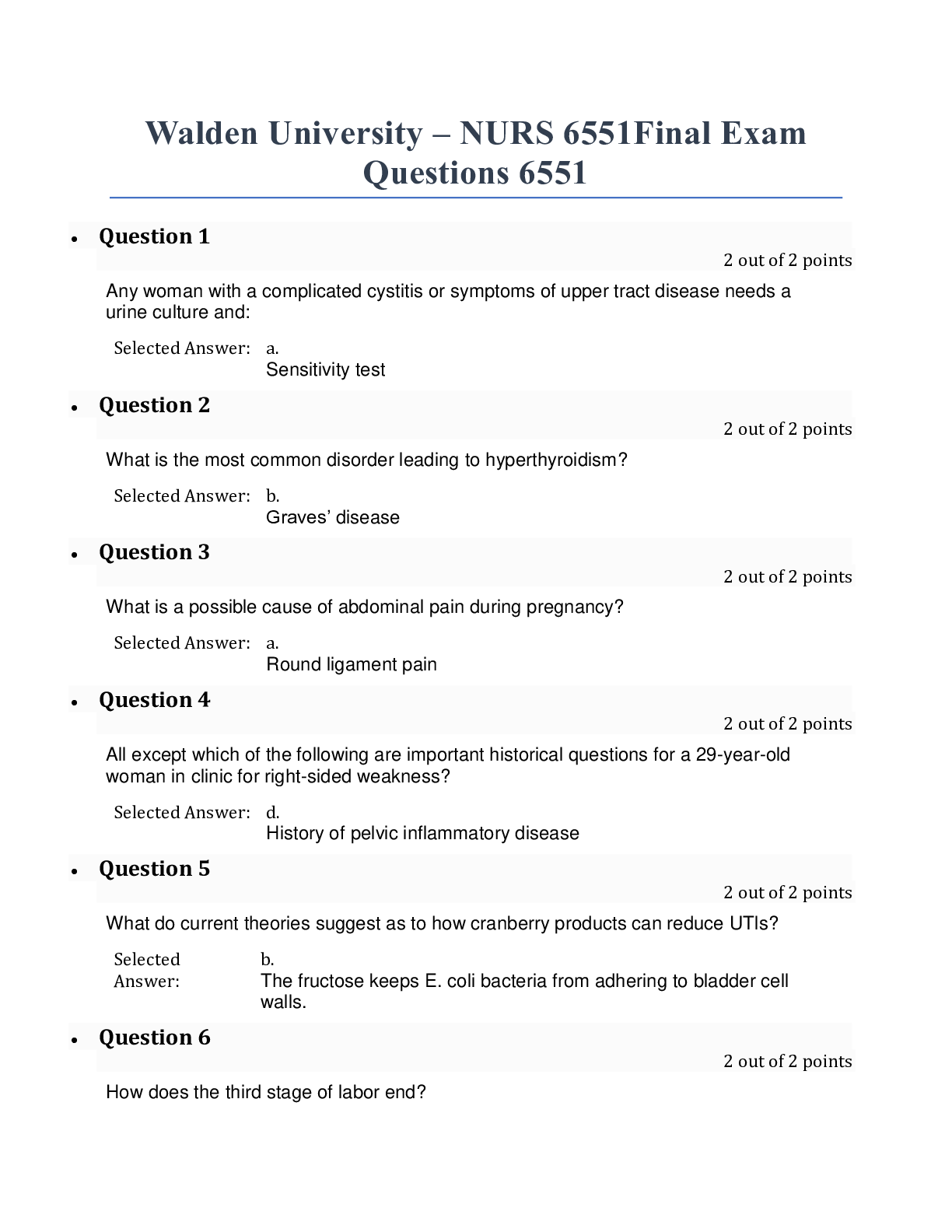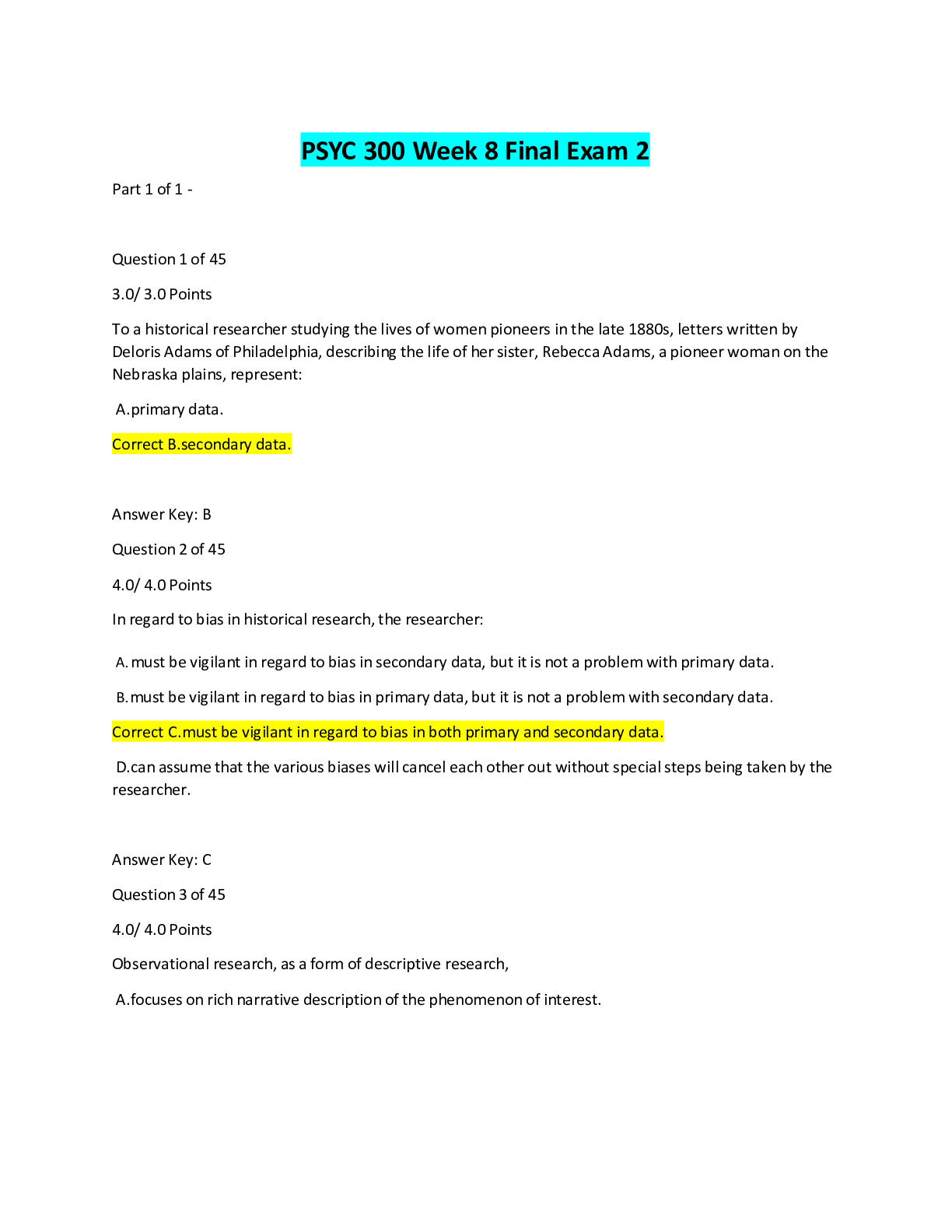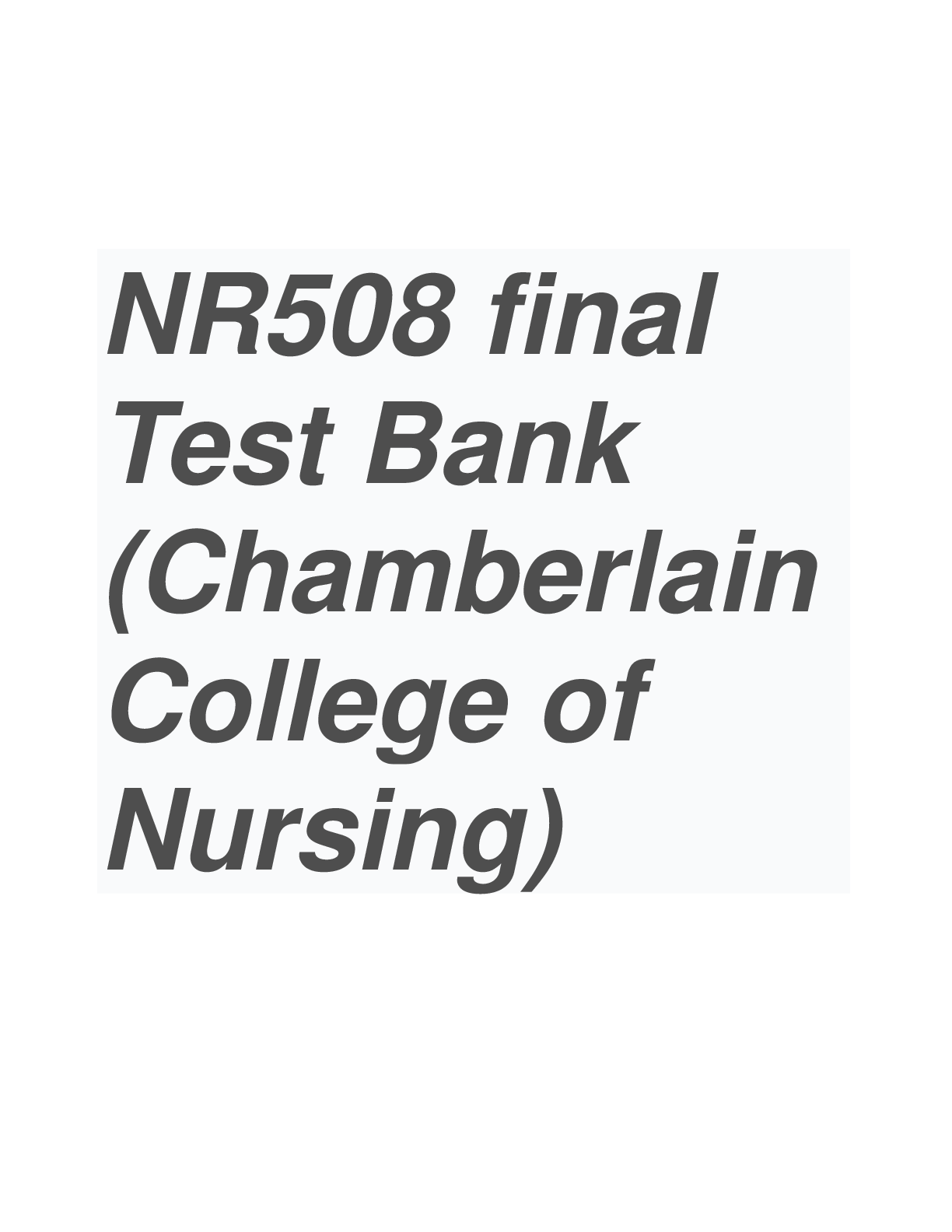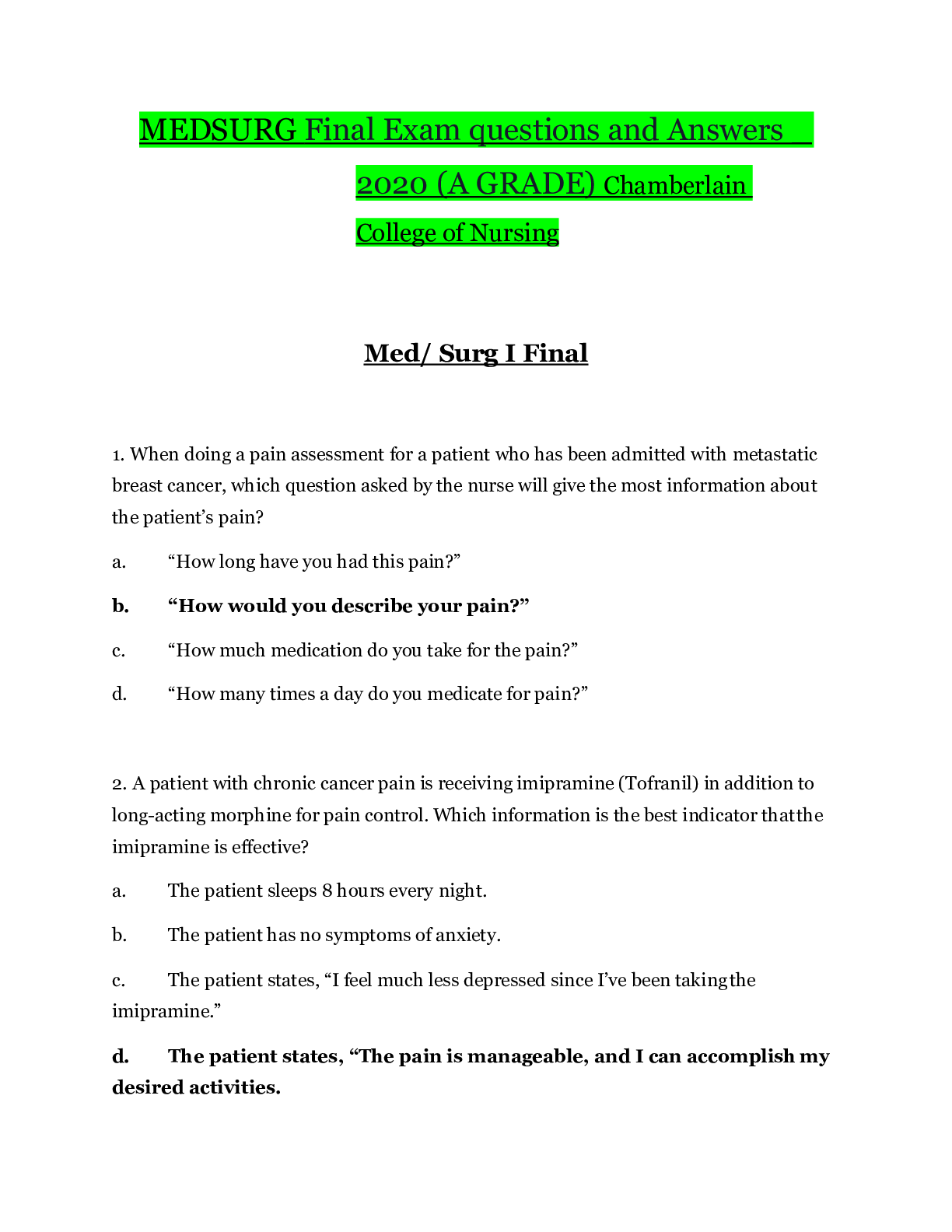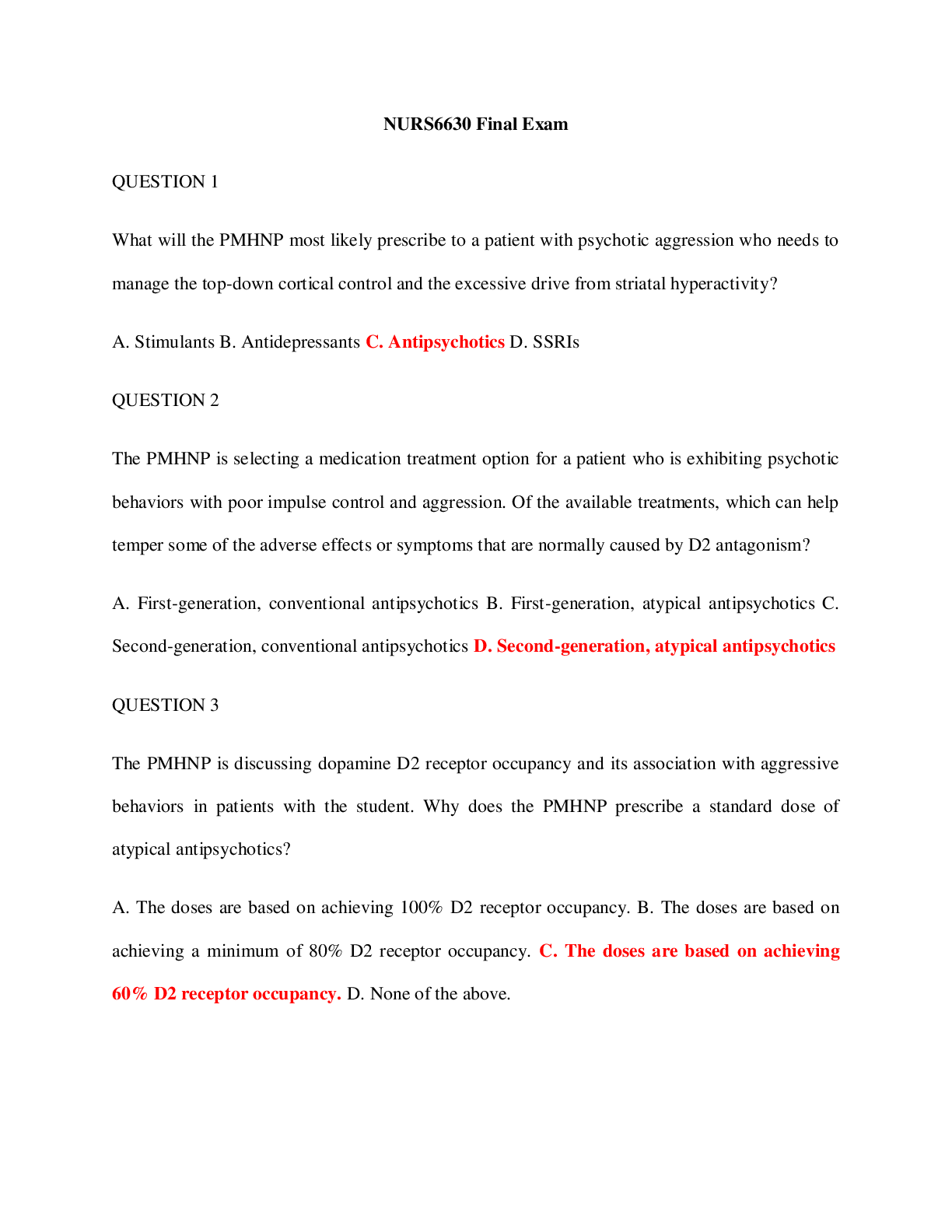*NURSING > QUESTIONS & ANSWERS > Multidimensional Care 2 (MDC 2) final exam questions with correct answers. (100% Correct) (All)
Multidimensional Care 2 (MDC 2) final exam questions with correct answers. (100% Correct)
Document Content and Description Below
Mdc2 final exam Question 1 A nurse is caring for a client that has recently been diagnosed with ulcerative colitis. Which of the following statements by the client would indicate an understanding of... the disease process? A. “It is caused by an inflammatory process of the gastrointestinal tract." B.” Diet modification can cure the disease." C.” I have to avoid eating nuts and seeds." D. “I am at a lower risk of developing cancer." Question 2 The nurse is providing care for a client who underwent a parathyroidectomy two days ago. To prevent complications with this surgery, which laboratory value requires close monitoring by the nurse? A) Serum calcium levels (B) Serum sodium levels (C) Serum potassium levels D) Serum blood glucose levels Question 3 The nurse instructs the client on prolonged cortisol therapy to report which signs and symptoms? A. Anuria and hypoglycemia B. Weight gain and moon face C) Anorexia and muscle twitches D) Hypotension and fluid loss Question 4 The nurse is assessing a client recently diagnosed with leukemia. Which of the following assessment findings would support that diagnosis? A) Blood in stool B) Petechiae or ecchymosis C) Blood in urine D) Cough or hoarseness Question 5 A nurse is caring for a client who recently underwent a colon resection for colorectal cancer. The client is post-op day two and has developed a fever. Vital signs are a temperature of 102 degrees F, heart rate 126 beats/minute, blood pressure 100/50 mm Hg. The client is complaining of increased abdominal pain. Based on this information, which of the following conditions is the client exhibiting? A) Deep vein thrombosis B) Peritonitis C) Appendicitis D) Intestinal obstruction Question 6 After completion of external radiation treatment for cancer, a client tells the oncology nurse about an upcoming vacation to the beach to celebrate. What response by the nurse is most appropriate to the client? A) “Avoid submerging in saltwater on the radiation site." (B) "Have a wonderful time and enjoy your vacation!" C) “Protect your skin, avoid exposure of the radiation area to direct sunlight." D) “Remember you should not drink alcohol for a year." Question 7 A nurse teaches a client who is diagnosed with diabetes mellitus. Which statement would the nurse include in this client's plan of care to delay the onset of microvascular and macrovascular complications? A) “Maintain tight glycemic control and prevent hyperglycemia." B) “Restrict your fluid intake to no more than 2 L a day." C) “Prevent hypoglycemia by eating a bedtime snack." D) “Limit your intake of protein to prevent ketoacidosis." Question 8 The nurse is caring for a client with a new diagnosis of adrenal insufficiency. Which of the following would the nurse expect upon assessment? (Select all that apply). A) Hypotension B) Polyphagia C) Hyponatremia D) Hyperkalemia E) Hyperpigmentation Question 9 The nurse is providing care to a client diagnosed with fluid-volume deficit. Which of the following assessment data is of greatest concern? A) There is prolonged skin tenting over the sternum B) Oral fluid intake is 100 ml for the last 8 hours C) The blood pressure is 86/40 mm Hg (D) Urine output is 40 ml over the last hour Question 10 The nurse is caring for a client diagnosed with diverticulitis. Which of the following orders would be expected for this client? A) Stool softeners to prevent constipation which will lead to further complications. (B) Laxatives to ensure passage of fecal matter through the intestines. C) An enema to attempt to flush out the undigested food trapped in the diverticula. D) A diet consisting of protein from seeds and nuts. Question 11 A nurse is reviewing lab values for a client and notes a potassium level of 2.3 mEq/L. What is the nurse's priority? A) Assess the client’s cardiovascular status B) Initiate fall precautions C) Place seizure pads on the bed D) Order a high potassium diet Question 12 After chemotherapy for cancer, a client develops chemotherapy induced nausea and vomiting (CINV). For this client, the nurse should give the highest priority to which action in the plan of care? (A) Serving small portions of bland food B) Encouraging rhythmic breathing exercises C) Administering an antiemetic medication as prescribed D) Withholding fluids for the first 4-6hrs after chemotherapy administration Question 13 The nurse is caring for a client with end-stage renal failure. PaO2 is 94 mm Hg. Arterial blood gases indicate that she is experiencing metabolic acidosis with partial respiratory compensation. Which of the following arterial blood gases support this? A) pH=7.32, PaC02=48 mm Hg, HCO3=18 mEq/L (B)pH=7.33, PaC02=31 mm Hg, HCO3=19 mEq/L C) pH=7.37, PaC02=33 mm Hg, HCO3=18 mEq/L (D) pH=7.47, PaC02=50 mm Hg, HC03=30 mEq/L Question 14 A client was admitted with the following arterial blood gas (ABG). How does the nurse interpret these results? PH 7.48 PaC02 30 mm Hg Hc03 18 mEq/L Pa02 85 mm Hg A) Metabolic alkalosis with partial respiratory compensation. B) Respiratory alkalosis with partial metabolic compensation. C) Metabolic acidosis with partial respiratory compensation. D) Respiratory acidosis with partial metabolic compensation. Question 15 A nurse is caring for a client with an opioid overdose. The client is difficult to arouse. The vital signs include blood pressure 90/60 mm Hg, respirations 10/minute, heart rate 60 beats/minute. The arterial blood gas (ABG) results include a PH 7.34, PaCo2 48 mm Hg, Hc03 24 mEq/L, PaO2 of 76 mm Hg. How would the nurse interpret these results? A) Respiratory acidosis not compensated with hypoxemia. (B) Metabolic acidosis not compensated with normal oxygenation. C. Respiratory acidosis with partial metabolic compensation and hypoxemia D.? D is missing but B is the answer. Question 16 Which of the following surgical procedures is appropriate for a client with chronic pancreatitis? A) Radical pancreatectomy B) Sphincterotomy (C) Fistulotomy D) Proctocolectomy Question 17 The nurse is providing discharge education to a client diagnosed with anorexia nervosa. Which statement by the client would indicate the client needs further education? A) “I need to keep a food journal of my progress, food intake, and timing of meals." B) “If I feel constipated, I will start an over-the-counter oral laxative." C)” I will schedule an outpatient session with a counselor to talk about my fear of gaining weight." D)” I will take my multivitamins, zinc, and iron as prescribed to prevent malnutrition." question 18 A nurse assesses a client who is recovering from an ileostomy placement. Which clinical manifestation would alert the nurse to contact the health care provider urgently? A) bluish stoma B) Liquid stool C) Ostomy pouch intact D) Blood smeared output Question 19 A nurse is caring for a client admitted with mild acute pancreatitis. Which of the following are treatment options for the early stages of mild acute pancreatitis? (Select all that apply.) (A) Nothing by mouth for 24 to 48 hours B) Assess and manage pain C) Encourage early oral nutrition D) Assess labs for amylase and lipase levels E) Measure and document accurate intake and output. Question 20 A nurse is caring for a client admitted for an exacerbation of Crohn's disease. A nasogastric (NG) tube has been placed and is connected to suction, and the client is currently receiving an infusion of total parenteral nutrition via a peripherally inserted central catheter (PICC) line. Which of the following actions should the nurse take? A) Place the parenteral nutrition solution on a warming device during infusion. B) Remove unused parenteral nutrition after 12 hours of use. C) Monitor laboratory values and assess for abnormal respiratory or cardiac functioning. D) Monitor the flow rate of the parenteral nutrition carefully and increase the rate as needed if it falls behind. Question 21 The nurse is caring for a 46-year-old female client who presented to the emergency department with dizziness, nausea, vomiting, and fatigue over the past few days. The client has recently been diagnosed with breast cancer and has been undergoing chemotherapy. The client's labs reveal the following: Na 150 mEq/mL, potassium 3.0 mEq/mL, calcium 15 mg/dL. Which of the following imbalances is the client exhibiting? A) Hypervolemia, hypercalcemia, hyperkalemia B) Hypernatremia, hypokalemia, hypercalcemia C) Hyponatremia, hypercalcemia D) Hypovolemia and hypercalcemia Question 22 A client was admitted with the following arterial blood gas (ABG). How does the nurse interpret these results? PH 7 44 Pa€02 50 mm Hg Hc03 32 mEq/L Pa02 90 mm Hg A) Metabolic alkalosis with full respiratory compensation (B) Respiratory alkalosis with full metabolic compensation C) Metabolic acidosis with full respiratory compensation (D) Respiratory acidosis with full metabolic compensation. Question 23 The nurse is assessing a client diagnosed with type 1 diabetes mellitus for symptoms associated with diabetic ketoacidosis. Which of the following will the nurse most likely assess in this client? (Select all that apply.) A) Fluid overload B) Fruity breath odor C) Altered mental status D) Bradycardia E) Kussmaul breathing Question 24 A client is diagnosed with metastatic cancer. The family asks the nurse, "What's the difference between hospice and palliative care?" The nurse correctly responds with which statement? A) Hospice is for clients with a prognosis of less than 12 months to live." B) Hospice care allows for continued chemotherapy treatments, and palliative care does not." C) Palliative care is to prevent and treat symptoms and side effects of cancer treatments." D) Palliative care requires revaluation every 30 days." Question 25 A 56-year-old male was recently diagnosed with type 2 diabetes. Which of the following diagnostic tests would correlate with this diagnosis? (Select all that apply.) A) Increased hemoglobin A1C B) Increased random blood glucose C) Increased fasting blood glucose D) Increased hemoglobin E) Missing but abc is the right answers Question 26 Which of the following is a life-threatening emergency and serious complication of untreated or poorly treated hypothyroidism? A) Endemic goiter B) Thyroid storm C) Myxedema coma D) Multinodular toxic goiter Question 27 A 42-year-old female presents to the emergency room with mid-upper abdominal pain radiating to her right shoulder, rebound tenderness, nausea, and dyspepsia. Based on the client's presentation, which of the following does the nurse anticipate is the client's diagnosis? A) Pancreatitis B) Cholecystitis C) Appendicitis D) Diverticular disease Question 28 A nurse is planning to educate a client diagnosed with fluid volume overload. Which of the following would the nurse educate the client to determine gains and losses in fluid? A) Presence of edema B) Skin turgor C) Appearance of mucous membranes (D Monitor daily weights Question 29 A nurse is caring for a 60-year-old female that underwent a surgical procedure and is post-op day four. The client has no active bowel sounds, no bowel movement, and no flatulence. Which of the following does the nurse suspect the client is experiencing? A) Perforated colon B) Appendicitis C) Peritonitis D) Non-mechanical bowel obstruction Question 30 A client was admitted with the following arterial blood gas (ABG). How does the nurse interpret these results? PH 7.32 PaC02 50 mm Hg Hc03 30 mEq/L Pa02 75 mm Hg A) Metabolic alkalosis with partial respiratory compensation (B) Respiratory alkalosis with partial metabolic compensation C) Metabolic acidosis with partial respiratory compensation D) Respiratory acidosis with partial metabolic compensation Question 31 An older adult client reports lack of energy and needs several naps throughout the day. Which problem may these symptoms be associated with that is often seen in older adults? A) Hypothyroidism B) Hyperparathyroidism C) Overproduction of cortisol D) underproduction of glucagon Question 32 The nurse is evaluating the serum laboratory results on the following four clients. Which of the following clients would the nurse assess first? A) Client with osteoporosis with a serum calcium level of 8.1 mg/dL. B) A client with alcoholism and liver failure with a magnesium level of 1.6 mEq/L. C) A client admitted with abdominal pain and vomiting with a potassium level of 2.8 mEq/L D) A client with dehydration with a serum sodium level of 134 mEq/L. Question 33 The client has just received a round of chemotherapy and will be discharged home. The nurse is educating the client about the concerns of neutropenia and the continuing risk for infection. Which of the following statements would not be appropriate given the client's situation? A) “Avoid crowds and other large gatherings of people who might be ill." B) “Bathe daily, or wash armpits and perineal area twice daily with antimicrobial soap. C) “Wash your hands thoroughly with an antimicrobial soap before you eat and drink." D) “If you experience a fever, treat it with over-the-counter medications and report it to your physician if symptoms don't resolve in 48 hours." Question 34 The laboratory values of a client with diabetes mellitus include a fasting blood glucose level of 92 mg/dL and hemoglobin A1C of 5.9%. What are the nurse's interpretations of these findings? A) The client's glucose control for the fasting has been poor, and the overall control is poor. B) The client's glucose control for the fasting glucose and past 90 days demonstrates good control. C) The values indicate that the client has poorly managed their disease. D) The values indicate that the client needs further disease management education. Question 35 A client assessment reveals fatigue, poor memory, and weight gain. The lab results reveal elevated thyroid-stimulating hormone (TSH) and decreased T3 and T4 levels. The nurse knows that these are manifestations of which disorder? A) Hypothyroidism B) Hyperthyroidism C) Hypoparathyroidism D) Hyperparathyroidism Question 36 A nurse is caring for a client who was prescribed high-dose corticosteroid therapy for one month to treat a severe inflammatory condition in the intestines from irritable bowel syndrome. The client's symptoms have now resolved, and the client asks, "When can I stop taking these medications?" How would the nurse respond? A) The inflammation can't recur if you stop the medication." B) Once you start corticosteroids, you must be tapered off the medication." C) The medication can be stopped when you start feeling better." D) The drug must be stopped abruptly." Question 37 A client was admitted with the following arterial blood gas (ABG). How does the nurse interpret these results? PH 7.35 PaC02 30 mm Hg Hc03 17 mEq/L Pa02 92 mm Hg A) Metabolic alkalosis with full respiratory compensation B) Respiratory alkalosis with full metabolic compensation C) Metabolic acidosis with full respiratory compensation D) Respiratory acidosis with full metabolic compensation Question 38 A nurse is caring for an adolescent client who has a long history of diabetes mellitus and is being admitted to the emergency department confused, flushed, and with an acetone odor on the breath. Diabetic ketoacid suspected. The nurse should anticipate using which of the following types of insulin to be given intravenously to treat this client? A) NPH insulin B) Insulin glargine C) Insulin detemir D) Regular insulin Question 39 A 28-year-old female presented to the emergency room with complaints of abdominal pain, nausea, and vomiting for the past 24 hours. The client is afebrile, heart rate is 130 beats/minute, and blood pressure is 90/60 mHg. During the pain assessment, the client rates her pain a "10" on a scale of 0-10. The nurse notes the client's pain to be in the right lower quadrant region. Based on the assessment findings, which of the following would the nurse anticipate as the client's diagnosis? A) Cholecystitis B) Appendicitis C) Cohn's disease D) Ulcerative colitis Question 40 Which laboratory report is of the highest concern for the nurse to monitor for a client with bone marrow suppression receiving chemotherapy? A) Urine specific gravity B) Triglycerides C) White blood cell (WBC) count D) Serum prostate-specific antigen (PSA) Question 41 The nurse is providing discharge instructions to a client with Hepatitis B. Which of the following statements demonstrates an understanding of the discharge instructions? A) All food handling practices are the same when traveling overseas." B) I don't have to consider safe sex practices with this form of hepatitis." C) I won't share my shaving razors with my spouse." D) Chronic hepatitis will not lead to liver cirrhosis or liver cancer." Question 42 A nurse is caring tor a 5/-year-old Hispanic male who was recently diagnosed with Cushing's disease. Which or the following laboratory tests Validate the diagnosis? A) Elevated lymphocyte count B) Decreased late-night salivary cortisol test C) Decreased urine specific gravity D) Elevated urine cortisol level Question 43 A client with a history of vomiting complains of muscle weakness, heart palpitations, and nausea. The client's laboratory findings are as follows: Na 140 mEq/L and potassium 2.5 mEq/L. Which of the following electrolyte imbalances is the client exhibiting? A) Hypervolemia B) Hypocalcemia C) Hyperphosphatemia D) Hypokalemia Question 44 A client tells the nurse he is "so thirsty". The lab results reveal an antidiuretic hormone (ADH) deficiency and increased urine output with a low urine specific gravity (<1.005). What endocrine disorder is the client most likely experiencing? A) Diabetes insipidus B) Diabetes mellitus C) Myxedema D) Syndrome of inappropriate antidiuretic hormone secretion (SIADH) Question 45 A nurse is preparing to administer cephalexin suspension 2 grams PO daily given in four doses. Available is cephalexin suspension 250 mg/ 5mL. How many mL should the nurse administer in one dose? (Record answer as a whole number. Do not use a trailing zero.) 10 Question 46 A nurse is caring for a client recently diagnosed with Addisonian crisis. Which of the following signs and symptoms are consistent with this diagnosis? A) Hypernatremia B) Severe hypotension C) Vascular resistance D) Hypokalemia Question 47 The nurse would incorporate which of the following into the plan of care as a primary prevention strategy for reduction of the risk for cervical cancer? A) Yearly mammography for women aged 40 years and older B) Colonoscopy at age 50 and every 10 years as follow-up C) Administering the human papillomavirus (HPV) vaccine D) Yearly prostate specific antigen (PS) and digital rectal exam for men aged 50 and over Question 48 A medication order states, administer 100 mEq of potassium chloride PO twice a day. Available is potassium chloride oral solution 40 mEq/15 mL. How many mL should the nurse administer per dose? (Record answer as a whole number. Do not use a trailing zero.) 38 Question 49 A nurse is caring for a client in the emergency room after a motor vehicle accident. The client is unconscious with a cervical collar in place. The client has been diagnosed with syndrome of inappropriate antidiuretic hormone (SIADH) secretion. Which of the following lab values validates the diagnosis? A) Decreased serum sodium B) Increased serum sodium C) Decreased urine osmolality D) Decreased glomerular filtration rate Question 50 A nurse is preparing to administer levothyroxine 125 mcg PO daily. Available is levothyroxine 50 mcg tablets. How many tablets should the nurse administer per dose? (Record answer to the nearest tenth, or one decimal place. Use a leading zero if it applies. Do not use a trailing zero.) 2.5 Question 51 The nurse is assessing a client that displays a positive Chvostek's sign. Which of the following is this assessment finding a clinical manifestation of? A) Hypocalcemia B) Hypermagnesemia C) Hyponatremia D) Hyperkalemia Question 52 A nurse is caring for a client recently diagnosed with colorectal cancer. Which of the following lab values would confirm the diagnosis? A) Increased serum creatinine B) Decreased albumin C) Increased carcinoembryonic antigens (CEA) D) Decreased white blood count Question 53 The graduate nurse is caring for a child with suspected appendicitis, what intervention by this graduate nurse would be inappropriate or contraindicated in the care of this client? A) Contacting the health care provider immediately if the client reports sudden relief of pain. B) Positioning the client in semi-fowlers C) Administer an enema for constipation D) Administering pain medication every 4 hours PRN as ordered Question 54 Which nursing intervention helps to prevent adrenocortical insufficiency? A) Administering diuretic therapy B) Teaching the client about a low-sodium diet C) Discontinuing high-dose steroid therapy quickly D) Reducing high-dose steroid therapy gradually. Question 55 A client complains of weight gain, has thin extremities, a buffalo hump, moon face, and a protruding abdomen. The nurse realizes that this client is most likely to be diagnosed with which disease process? A) Addison's disease B) Cretinism C) Cushing' syndrome D) Pheochromocytoma Question 56 A nurse is caring for a client recently diagnosed with diabetes insipidus. Which of the following medications would be appropriate for this disorder? A) Furosemide B) Diltiazem C) Desmopressin D) Growth hormone antagonist Question 57 A nurse cares for a dying client. Which manifestation of active dying would the nurse treat first? A) Anorexia B) Incontinence C)Nausea D)Pain Question 58 A nurse is caring for a client who is postoperative following abdominal surgery. Which of the following findings would indicate to the nurse that the client's peristalsis is returning? (A) Hypoactive bowel sounds in two quadrants (B) Request for a cup of tea and some toast C) Passage of flatus D) Abdominal distention Question 59 A client underwent a colon resection with colostomy placement. Which of the following would the surgeon consult post-operatively for colostomy management? A) Dietician B) Respiratory therapy (C) Physical therapy D)Wound Ostomy Continence Nurse Question 60 A nurse is providing care to a client that is diagnosed with hypokalemia. After reviewing the client's current medications, which of the following might have contributed to hypokalemia? A) Corticosteroids B) Loop diuretics C) Opioids D) Beta-blockers Question 61 A nurse is teaching a client with diabetes mellitus who asks, "Why is it necessary to maintain my blood glucose levels no lower than about 60 mg/dL (3.3 mmol/L)?" How Would the nurse respond? A) Glucose is the only fuel used by the body to produce the energy that it needs." B) Your brain needs a constant supply of glucose because it cannot store it." C) Without a minimum level of glucose, your body does not make red blood cells." D) Glucose in the blood prevents the formation of lactic acid and prevents acidosis. Question 62 The nurse is caring for a diabetic client with a blood glucose of 56 mg/dL. The client is difficult to arouse. What action would the nurse take? A) Give a glass of orange juice with three sugar packets mixed in and monitor the client. B) Give a glass of milk and monitor the client. C) Give a complex carbohydrate and monitor the client. D) Administer 50% dextrose (D50) IV push per order and monitor the client. Question 63 The nurse knows which statement is true about age-related changes and the endocrine system in older adults? A) Decreased hormone sensitivity B) Thyroid hormone secretion decreases C) Adrenal glands enlarge D) The thyroid gland enlarges Question 64 A nurse is caring for a client who has diverticulitis. Which of the following is a clinical manifestation of diverticulitis? A) Generalized upper abdominal pain B) Hypertension C) Localized lower abdominal pain D) Bradycardia Question 65 A nurse is caring for a client recently diagnosed with cirrhosis. Which of the following are appropriate nursing interventions for this client? (Select all that apply.) A) Pain management B) Monitor lab values C) Strict bedrest for 48 hours D) Allow moderate alcohol intake in diet E) Fiber restriction from diet Question 66 A client was admitted with the following arterial blood gas (ABG). How does the nurse interpret these results? PH 7.45 PaC02 29 mm Hg Hc03 17 mEq/L Pa02 88 mm Hg A) Metabolic alkalosis with full respiratory compensation. B) Respiratory alkalosis with full metabolic compensation. C) Metabolic acidosis with full respiratory compensation. D) Respiratory acidosis with full metabolic compensation. Question 67 The nurse is caring for a client diagnosed with cholelithiasis. Which of the following nursing instructions should be included as part of the discharge teaching? A. "Call the provider if you have ten or more bloody stools in a 24- hour period." B. "You should limit high-fat meats and fried foods from your diet." C. "Removing gluten from your diet can reduce cramping." D. "Reduce foods high in uric acid from your diet, like anchovies and venison." Question 68 A nurse is educating a newly diagnosed type 1 diabetic client. Which education topic is the nurse's priority? A. Signs and symptoms of hypoglycemia B. Sexual dysfunction can develop C. Carbohydrate counting D. Exercise vigorously only if blood glucose is 100- 250 mg/dL Question 69 Which of these laboratory results would be the most important for a nurse to monitor for a client with a lower gastrointestinal bleed? A. Hemoglobin and hematocrit B. Bleeding time C. Platelet count D. Potassium level Question 70 A nurse is providing teaching to a client about hyperglycemia. The nurse should recognize that the client understands the teaching when he identifies which of the following as manifestations Specific to hyperglycemia? (Select all that apply.) A. Polyuria B. Hypervolemia C. Polydipsia D. Bradycardia E. Polyphagia Question 71 A nurse is providing client and family education for a client diagnosed with irritable bowel syndrome. Which of the following is important to include in the education? (Select all that apply.) A. Modify diet B. Stress reduction C. Adhere to prescribed medications D. Limit physical activity E) Limit fluid intake Question 72 A nurse is caring for a client recently diagnosed with thyroid cancer. Which of the following lab results will validate this diagnosis? A. Increased serum calcium level. B. Increased serum phosphorus level. C. Increased serum thyroglobulin (TG) level. D. Decreased serum thyroglobulin (TG) level. Question 73 Which of the following teaching instructions would not be accurate as a prevention strategy to reduce the risk of oral cancer? A. “Visit a dentist every two years”. B. “Stop use of tobacco and alcohol”. C. “Avoid exposure to human papillomavirus (HPV)”. D. “Avoid sun exposure to lips”. Question 74 An eight-month-old infant is hospitalized with severe diarrhea. The nurse knows that which of the following is the major problem associated with severe diarrhea? A. Pain in the abdominal area. B. Electrolyte and fluid loss. C. Presence of excessive flatus. D. Irritation of the perineal and rectal area. Question 75 Which of the following signs or symptoms indicate a possible upper gastrointestinal (GI) bleed? (Select all that apply.) A. bright red or coffee ground vomitus B. increased blood pressure C. Vertigo D. Weak peripheral pulses E. Increased hemoglobin and hematocrit [Show More]
Last updated: 9 months ago
Preview 1 out of 22 pages
Instant download
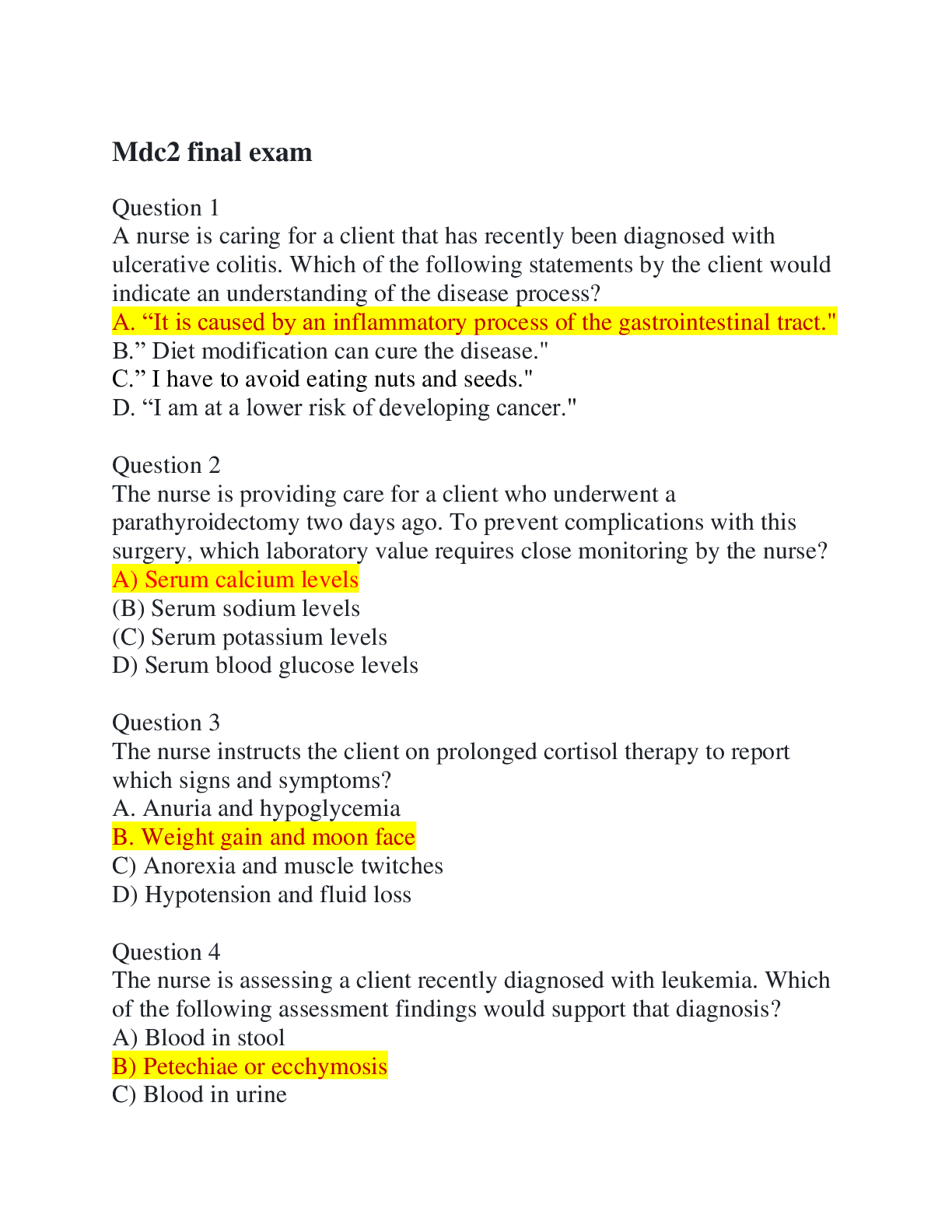
Buy this document to get the full access instantly
Instant Download Access after purchase
Add to cartInstant download
Reviews( 0 )
Document information
Connected school, study & course
About the document
Uploaded On
Sep 07, 2023
Number of pages
22
Written in
Additional information
This document has been written for:
Uploaded
Sep 07, 2023
Downloads
0
Views
96

